Block-modular mobile water treatment stations "Aquamobil"

Often for the solution of tasks, water purification and water treatment, mobile water treatment stations are required. Soltek proposes to solve such problems with the help of container water treatment stations.
Advantages of such stations: small size - that allows to deliver the station to any point without problems. Despite the small size of the water treatment station, it interferes with all necessary equipment for complex qualitative water-sensitive.
Mobile container station carries out fine and coarse filtration, ultraviolet irradiation, sorption, membrane and ion exchange water purification.

MAIN CHARACTERISTICS
- objects of housing and communal services, shift camps and settlements;
- enterprises of gas, oil, mining and metallurgy, food and pharmaceutical industries;
- military units and units of the Ministry of Emergency Situations;
- objects of social sphere, hotel, sanitary-resort and sports complexes of the energy complex;
- enterprises of transport infrastructure;
- reconstruction of existing and construction of new productions;
- enterprises of seasonal productions;
- seasonal or temporary change of the source water source;
- pilot production;
- emergency water supply of the enterprise, consuming boiler water and water for steam generators.
ADVANTAGES OF MASS BROADCASTING BEFORE STATIONARY STATIONS
- It is not required to build special premises for equipment;
- Full readiness of the water treatment plant for operation;
- Convenient transportation; Convenience for maintenance on an open area
MAIN CHARACTERISTICS
- Overall dimensions (L x W x H, m) 6.5х2.5х2.5 or 12х2.5х2.5;
- Insulation "Ursa" (in the execution of "North") is not less than 100mm;
- External and internal finishing;
- Reinforced by the channels of the floor;
- The floorboard is covered with a metal sheet;
- Interior lighting;
- Heating system;
- Fire extinguisher, box with sand;
- Technological equipment
- Permanganate oxidation not more than 8 mg O2 / L
- pH not less than 6.8
- Inlet pressure 2.5 - 6.0 bar
- Initial water temperature 50С - 350С
- Total iron not more than 3.5 mg / l
- Stiffness is not more than 7.0 meq / liter
- The content of manganese in water is not more than 0.5 mg / l
- The content of hydrogen sulphide in water is not more than 0.05 mg / l
Equipment
- Aeration column;
- Aeration kit;
- Air vent;
- The compressor assembly - 2 pcs .;
- Pulse flowmeter;
- Filter housing;
- Drainage and distribution system (DRS);
- Supporting layer of gravel;
- Filtering material;
- Automatic filter control unit;
- Disinfection chamber;
- Quartz cover;
- UV sensor;
- Ultraviolet lamp;
- The control panel (control cabinet on request);
- The system of chemical and mechanical cleaning on request
"R1 GROUP" Association is one of the leading engineering companies of the Ural region, offers its services in designing, manufacturing, supplying and assembling systems of water treatment and water treatment.Our website contains products and engineering solutions designed to provide technical and drinking water industrial enterprises, housing and communal services, medical institutions, catering enterprises, children's institutions, shift camps and other organizations. The proposed technologies of water treatment, water treatment are integrated solutions to provide water of the required quality, the effectiveness and reliability of which is confirmed by experience of operation in various industries and geographic regions.
Water treatment systems «R1 GROUP»this:
- Complex approach (from design to delivery of the finished object "turnkey");
- Experience in implementing projects of varying complexity, including in severe climatic conditions;
- Own modern production site in Yekaterinburg;
- Production of water treatment plants "Ermak - Pure Water" in block-modular design of the full factory readiness;
- Own production of components of water treatment systems, cooperation with the world's leading manufacturers;
- Highly qualified engineering and technical personnel;
- Operational departure of the service center specialists to the Customer in any region of Russia;
- High quality of all manufactured products.
Risks of using dirty water
Use of unprepared water from a water supply system, surface sources or groundwater in the communal economy or for production purposes very often negatively affects the flow of technological processes. Water that has not been cleaned up increases the wear of technological equipment units up to emergency situations, threatens people's health, leads to the appearance of scale, increases the frequency of equipment stops for maintenance.
Industrial water treatment
Make water safe and technologically suitable will help industrial water treatment. In the range of «R1 GROUP» equipment - chemical water treatment plant (water treatment plant), water purification filtersfrom iron ( deironing), bactericidal (water disinfection) and magnetic treatment of water.
We supply both integrated water treatment and water treatment plants, as well as individual devices intended for various facilities and enterprises. We offer a wide range of water treatment stations in block-modular design, multicomponent water treatment systems for boilers, housing and communal services, manufacturing enterprises various industries.
All water treatment systems are certified, and comply with accepted environmental standards. Always available cartridges and downloads for supplied water purification filters.

Purification of water from any contamination
Specialists of our company will help you choose equipment to eliminate any impurities that pollute the water. Impurities have a different nature:
- insoluble impurities are in a solid state, forming suspensions, determining the color and turbidity of water;
- soluble impurities are of a saline nature and form acidity, stiffness, color and taste of water;
- organic components change the physico-chemical properties of water, and become an active source of bacterial contamination.
To remove impurities from water in water treatment systems, various cleaning principles are used. Mechanical water treatment removes solid suspensions, sand, rust, as well as some organic substances (oil, fat, paraffin, products of chlorination of organic compounds) by filtration. Mechanical water purification is carried out by cartridge filters, screen filters, sedimentary filters, and also with the help of self-cleaning filters. Water softening , the removal of dissolved gases, in particular chlorine, and the removal of iron by filtration through special catalytic charges.
We offer equipment for multi-stage water treatment and separate water purification filters , eliminating certain pollution, as well as equipment for magnetic treatment of water.
In the equipment catalog you can find detailed information about the cleaning stations we offer, which together form a complete cycle of preparation, use and disposal of industrial water, methods industrial water treatment.
Engineering solutions in the field of water treatment and water treatment "on a turn-key basis"
Our desire to remain the best in the market of the provided services all the time moves us forward, forcing the company to improve. We offer equipment for water treatment of our own production and production of leading foreign manufacturers: block-modular water treatment stations Ermak-Pure Water, universal water treatment stations, mechanical water purification filters (cartridge "FMNZ", mesh, self-washing, sedimentary), water deironing plants , filters for clarification of water (sorption), water softening plants, ultraviolet disinfection units, water desalination systems, antiscale devices (water treatment for a cat up). For more information on water treatment systems, see
Today I will tell about the Western water treatment station, which recently celebrated its anniversary - 50 years, while being the youngest water treatment plant in Moscow.
Water supply to Moscow is provided by four major water treatment stations: North, East, West and Rublevskaya. The first two sources of water use the Volga water, supplied by the Moscow Canal. The last two take water from the Moskva River. The performance of these four stations is not very different. In addition to Moscow, they also provide a number of water near Moscow cities. Currently, the Western station has a design capacity of 1,700,000 m 3 per day (and actually produces 1,200) and feeds mainly the south-western, southern and south-eastern parts of the city. In the future, will also feed part of the territories of New Moscow.
All the main water supply and sewerage in Moscow are managed by Mosvodokanal - one of the largest organizations in the city. To represent the scale: for energy consumption Mosvodokanal inferior only to two other organizations - RZD and the metro.
The western station is primarily remarkable for its location. It is far from the Moscow River and I, like many, once had a question - where does it get the water from? It turned out that the water is taken from the Moskva River and then, not cleaned, about 15 kilometers through pipes pumped to the station.
On the map:
1 (red mark) - Western water treatment plant.
2 (blue mark) - West station water intake and first lifting pumps.
3 (green mark) - Rublevskaya - the oldest water treatment plant in Moscow and the Rublevsky hydrounit.
The blue line is the path of "dirty" water from the Moscow River to the station.
Such a solution enabled clean water south-western and southern parts of the city. No other stations could do this.
The western water treatment plant is notable for the fact that Mosvodokanal is testing and debugging all new technologies for water purification, and then it is already transferring them to the other three stations.
Let's start with the control room. All processes at the station are controlled and controlled from it. In the dispatch office around the clock work two women. They in real time receive all the information from the whole huge station.
The station is really huge - from corner to corner the territory has a length of almost one and a half kilometers.
All conceivable and inconceivable information flows here - data of monitoring of water parameters at the inlet, outlet and all intermediate stages of purification, data on the technological process, data on the status of different equipment, the capacity of the tanks, etc.
Control of water quality is serious. At least three independent authorities check the cleaned water: Mosvodokanal itself, the contract organization and Rostekhnadzor. The check is performed not only at the exit from the station, but also in different parts water supply network in Moscow.
We move to one of the water purification units. This is the most modern block built on the station. The design capacity is 250 thousand m 3 per day. Pay attention to the stepped shape of the building - it corresponds to the sequence of water purification - as the water purifies itself, gravity flows lower and lower.
Here, perhaps it is worth to tell a little about the main stages of water purification.
First of all, water is taken from the river, where it is cleaned of large debris, fish, etc. and pumps the first lift is pumped to the station. Then the water enters the mixer, where various substances are added to it - coagulants and floatants, which help precipitation. All those impurities that are in the water turn into flakes and sediment. Then the water is sent to a sump where most of the impurities remain. The next stage is sand filters. Through them, water slowly seeps, leaving most of the contaminants. Further - ozonization. This is a new stage, cleaning, which was not previously used. The essence should be clear by name - in the water supply a large amount of ozone, which is good for purifying water, destroying various impurities. The last step is to pass water through the carbon filters. After that, sodium hypochlorite is added to the water. Water accumulates in reservoirs, from where the pumps of the second rise are fed to the city.
Now we will repeat the same way, but already on the terrain. Pumps of the first rise are at a great distance from the station, so it was not possible to look at them. But they are similar to the pumps at the Rublyovskaya station and can be viewed in report from it.
Let's start with the mixer. I admit honestly - I still do not understand exactly where he is, but somewhere in the depths of this part of the block. Here comes the "dirty" water and various reagents are added to it, depending on the specific parameters of the water. they change, for example in the spring, in high water, it is obvious that the water is not at all like in winter.
At the next stage, water enters the flocculation chamber, which takes about 30 minutes. In the chamber, she slowly interferes with a special device with a motor.
The whole further path of water lies through such "clean" zones.
Water enters the so-called overflow trays.
They do not miss flakes, sediments and film.
The water flows in thin streams into the tray and flows further for cleaning, while large contaminants settle and are removed by a special mechanism.
The next stage is sand filters.
The principle of operation is extremely simple - water seeps through layers of sand of different granularity, leaving all kinds of pollution in this sand.
The average water speed at this stage is 6 meters per hour. Of course, the filters are polluted and washed (as far as I understand, these blue tubes are used for this). The filter is fed with water under pressure and it flushes all the dirt, after which it is ready to work again.
Very pleased with the modern equipment at the station.
And in particular, as an electronics man these locking mechanisms with a beautiful display :)
They are managed remotely, however almost like everyone at this station. For a couple of hours of walking through the huge block, we did not meet a single employee - everything is very well automated - it turns itself on, off and controlled. There is absolute purity and order everywhere.
By the way, about control. To control the water there is a separate room (probably not one), where a lot of pipes come.
A lot of measuring equipment is connected to the pipes.
Just with these (but not only) devices and information enters the control room.
After the sand filters, the water enters the ozonation. The process occurs somewhere beyond the wall and you can not look at it - ozone is an extremely dangerous gas and everything happens in a closed volume. But I will allow myself to send again to report from the Rublevskaya station - in it the issue of ozonation is fully disclosed - starting from the beautiful process of obtaining ozone and ending with peering through the porthole into the ozonation tank.
The next "step" is the transition to the next stage of water purification. You can estimate the size of the block by people :)
Just beautiful pipes.
The next stage is coal filters.
The coal is black, so you can not see anything :)
This is the last stage of water purification. Coal with time loses its properties and it is gradually changing, about 5-10% of the load per year.
When we were already gone we managed to see from afar the process of washing the coal filter. In the photo you can see the flow of water flowing directly out of it.
Before the water is released into the city's networks, it is chlorinated. This is done not because the water is dirty or contaminated, but because in the vast Moscow water supply network (thousands of kilometers) there can inevitably be areas with stagnant water. That the water does not "blossom" in such areas into it and add chlorine. And here there is one significant innovation that Mosvodokanal is very proud of.
Previously, liquid chlorine was used as a reagent, and now sodium hypochlorite. From the point of view of the safety of the resulting water, there is no difference between them - it is safe anyway. But with liquid chlorine it is very difficult and dangerous to work. It is dangerous to drive in cars, it is dangerous to store it in containers. When in Soviet times water treatment stations were far "in the fields" this was not a big problem. Now around the stations, residential areas grew and any leakage of liquid chlorine could lead to very bad consequences. Hypochlorite sodium is also safe (in everyday life it is often used as a bleach). It can be transported and stored without special precautions. The Western water treatment plant was the first to completely switch to the use of sodium hypochlorite.
A special warehouse with huge tanks was built for its storage (if I'm not mistaken with capacities of 50 and 90 cubes or so).
The tanks contain approximately two-week supply of reagent for a hypothetical case of supply disruptions.
From the tanks, the reagent is mixed with water through special pumps and valves.
Each of the pumps works about once a second, and together they all produce quite amusing sounds :)
That's all, the purified water enters the huge underground reservoirs. They are needed in order to smooth out the daily consumption peaks. The station at the same time works in a constant mode, without sharp changes. From the reservoirs, water is pumped into city networks by pumps of the second lifting.
Faced the need for water purification? The company "VODEKO" offers to purchase block-modular structures for this task. This compact structure will provide clean water for both a residential building and a small industrial enterprise. The design is certified, safe and can be installed almost everywhere.
The manufacturing of such a design takes from 30 to 50 days. This time is enough to collect it from environmentally friendly materials and test the work of all elements.
Why do I need a water treatment plant?
Block-modular station for water purification is a unique and universal solution. It is capable of effectively and year-round filter out excess impurities and chemical elements from the liquid.
That is why water abstraction can be carried out from any natural body of water. By specially laid pipes, it enters a block-modular design. There, passing through a number of filter elements, the water is cleaned of contaminants and various impurities. After that, it leaves the structure and is sent to the consumers.
The water that has been treated completely corresponds to the sanitary and hygienic standards. It can be used for any household and industrial tasks.
What is a modular water treatment plant?
Mobile block-modular water treatment stations consist of the following elements:
- frame and walls of light and corrosion-resistant metal with additional internal insulation;
- ventilation system of the internal space, maintaining the optimum level of temperature and humidity;
- a complex of filter components and pumps, which is responsible for water purification;
- heating and lighting devices for comfortable debugging and replacement of consumables at any time of the year;
- security and fire alarms, which will avoid large losses in the event of an attack by intruders or the occurrence of fire.
All systems are interfaced, run smoothly and automatically. They are able to function without interruption for a long time without human intervention.

Characteristics of the block-modular water treatment station
The main parameter affecting the efficiency of a water treatment plant is its productivity, measured in the volume of water that it is able to pass through itself per day. The designs offered by VODEKO are universal. Depending on the configuration and needs of the end user, they are able to filter from 20 to 3000 m³ of water per day.
Block-modular water treatment system is designed for operation for a period of up to 20 years. After that, some of its parts may require replacement or major repairs. During the first year after the purchase, a guarantee is in force for the structure: all the shortcomings identified will be eliminated at the manufacturer's expense.
Together with the water purification system, a package of design and technical documentation is provided. In it you can find the following information:
- description and characteristics of the module;
- overall dimensions and design features;
- rules of operation of the water treatment system.
The only thing that needs to be done after the purchase is to install the block-modular system in place. To do this, lay the foundation. The design for water purification is lightweight, so you can use low-cost concrete grades. Important step - summarizing communications. A liquid source and electricity are needed to operate the water treatment module.
Leave an application on the site or call us and you will receive an individual offer for the purchase of a block-modular structure for water filtration from VODECO engineers!




